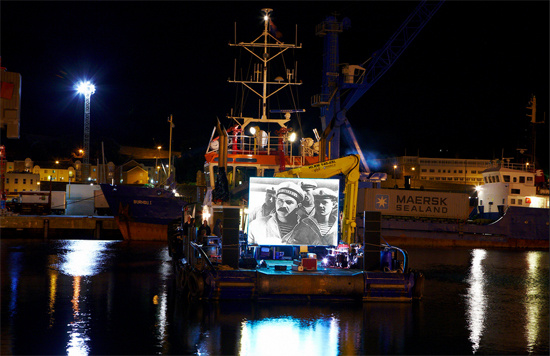
Luke Turner reports on The Branchage Film Festival 2010
The first people arrived on the reefs and rocks of Ecrehous many thousands of years ago, when it wasn’t a collection of reefs and rocks at all, but a few hillocks rising out of the landscape of Neolithic Europe. Now, an Ice Age and the relentless attention of some the world’s most powerful tides later, Ecrehous sits between the island of Jersey and the Normandy coastline. At low tide, its rocks and islets protrude far from the water, yet when the moon’s pull is at its strongest, just a few tips are visible from either coast.
Two of the islets, La Marmotchiéthe and La Maître Ile, are inhabited for part of the year, when a few Jerseyfolk sail over to stay in weatherbeaten huts. Although La Maître Ile is the largest, it has just two of these modern dwellings, along with ruined fisherman’s cottages and the foundations of a 13th Century priory, inside which stands a small menhir. Such places will always draw the spiritual and the mystic, the dispossessed and the patriotic. During the late 19th century, a man called Philippe Pinel set up camp on Les Ecrehous, from where he corresponded with Queen Victoria. In 1961 Jerseyman Alphonse Le Gastelois fled here after being accused of a series of horrific sex attacks on the Island. Although cleared, he refused to leave, declaring “”This is my home now. Jersey crucified me.”
Then there have been the periodic ‘invasions’ by groups of Frenchmen, who brought priests and flags and tried to lay claim to Les Ecrehous (which they spell Ecrehou – though the word is actually of Norse origin). They were sent packing without a shot being fired. The Boots family used to have a hut here, until it was burned down by Le Gastelois (he got off). I visited thanks to the kindness of a Jersey resident named Jerome Therese and the Branchage International Film Festival, which I reported on for Caught By The River in 2009.
This year, we had been supposed to come out to Les Ecrehous for a reading/performance by musician/writer/thinker Ian Svenonius (of Nation Of Ulysses, The Make Up, Weird War) but weather conditions had made it too dangerous… the Branchage Festival being what it is, this was no obstacle. Instead, the venue was changed to Seymour Tower, a hulking fortification which stands a mile across sands and around rocks from the Island proper. Seymour Tower, like many other forts around the coast, can be rented from Jersey Heritage. The history of this disputed island is frozen in the structures built to defend it, and Jersey Tourism do sterling work trying to build awareness of this. We’re guided to Seymour Tower by three Jersey Heritage volunteers, one of whom is Therese. Attempting to reach it as the crow flies will lead to you becoming lost in the bewildering maze of rocks and channels, an easy victim for the returning tide.
This sense of the power of the sea is never far away in Jersey, and while a paucity of road signs and baffling one-way-systems might heighten the feeling of a place difficult for outsiders and visitors, the island spirit seems to connect and infect anybody. Branchage – named for the Jersey system of enforcing a well-trimmed hedge – is never just about the films, or the unusual places in which they’re screened, despite this year’s rich programme: there was Went The Day Well in a barn, French Kosmische group Zombie Zombie playing along to Battleship Potemkin as it was projected onto the side of the Duke of Normandy tugboat in St Helier Harbour, Euros Childs and Richard James adding sound magic to Yuri Nordstein’s animations in a church, Robin ‘Scanner’ Rimbaud accompanying a Victorian magic lantern show, Superman projected onto a dam, and a full programme of documentaries, features and shorts.
Instead, visiting Jersey for Branchage makes it a place for finding friends and surprising new experiences. This is why on Sunday afternoon Jerome Therese takes myself and the Telegraph correspondent over to Les Ecrehous aboard his 45 knot rib inflatable. After bouncing and thudding over the swell we’re marooned while Therese goes to fish. I try to fish too, but this is another of those disappointing weekends where everyone else on the rock, boat or pier has the same gear, and it’s always exactly that which you don’t have. At Ecrehous, the contemporary French invaders of yachtsmen flick sand eel lures through the water.
But the bass not biting matters not a jot during three hours here. There are cormorant’s nests, sturdy, perfectly round, and white with droppings. There are the last four people finally closing their huts for the winter. There’s the excitement of trying to row a tiny dinghy across a channel into which the incoming tide is sweeping, and seeing the flag pole we’re using as a navigation point move inexorably sideways. There’s the uniquely strange position of being able to see the coasts of both Britain and France while stood on dry land, and thinking of how Therese insists we spell the place Ecrehou, his friend and fellow guide Dominic prefers the Anglicised Ecrehous. Apparently it’s a topic of frequent debate.
The sun starts to dip, the riptide strengthens, and the French sail away, their creels empty. The hut owners have gone too, their boats how dots on the horizon under the evening sky. Clambering aboard the rib to head into the sunset and back to dry land and the films of Branchage, I think of how we’re among the last to set foot upon Ecrehous before the autumn gales set in.